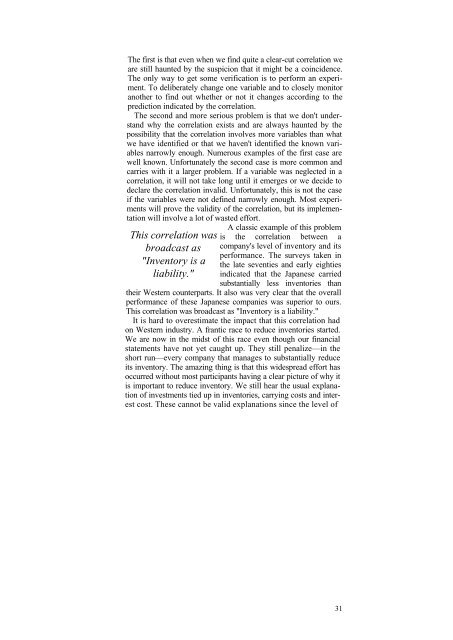THEORY OF CONSTRAINTS
THEORY OF CONSTRAINTS
THEORY OF CONSTRAINTS
Create successful ePaper yourself
Turn your PDF publications into a flip-book with our unique Google optimized e-Paper software.
The first is that even when we find quite a clear-cut correlation weare still haunted by the suspicion that it might be a coincidence.The only way to get some verification is to perform an experiment.To deliberately change one variable and to closely monitoranother to find out whether or not it changes according to theprediction indicated by the correlation.The second and more serious problem is that we don't understandwhy the correlation exists and are always haunted by thepossibility that the correlation involves more variables than whatwe have identified or that we haven't identified the known variablesnarrowly enough. Numerous examples of the first case arewell known. Unfortunately the second case is more common andcarries with it a larger problem. If a variable was neglected in acorrelation, it will not take long until it emerges or we decide todeclare the correlation invalid. Unfortunately, this is not the caseif the variables were not defined narrowly enough. Most experimentswill prove the validity of the correlation, but its implementationwill involve a lot of wasted effort.This correlation wasbroadcast as"Inventory is aliability."A classic example of this problemis the correlation between acompany's level of inventory and itsperformance. The surveys taken inthe late seventies and early eightiesindicated that the Japanese carriedsubstantially less inventories thantheir Western counterparts. It also was very clear that the overallperformance of these Japanese companies was superior to ours.This correlation was broadcast as "Inventory is a liability."It is hard to overestimate the impact that this correlation hadon Western industry. A frantic race to reduce inventories started.We are now in the midst of this race even though our financialstatements have not yet caught up. They still penalize—in theshort run—every company that manages to substantially reduceits inventory. The amazing thing is that this widespread effort hasoccurred without most participants having a clear picture of why itis important to reduce inventory. We still hear the usual explanationof investments tied up in inventories, carrying costs and interestcost. These cannot be valid explanations since the level of31




